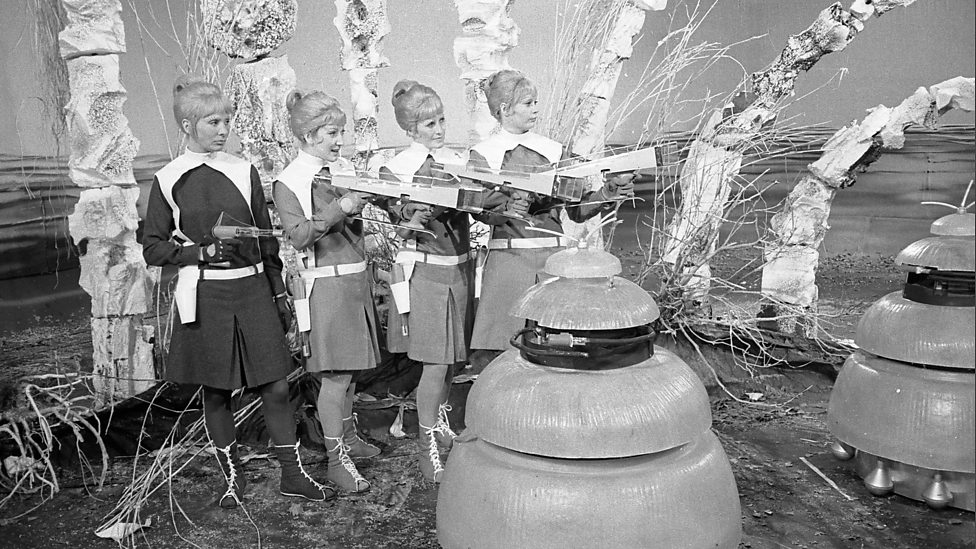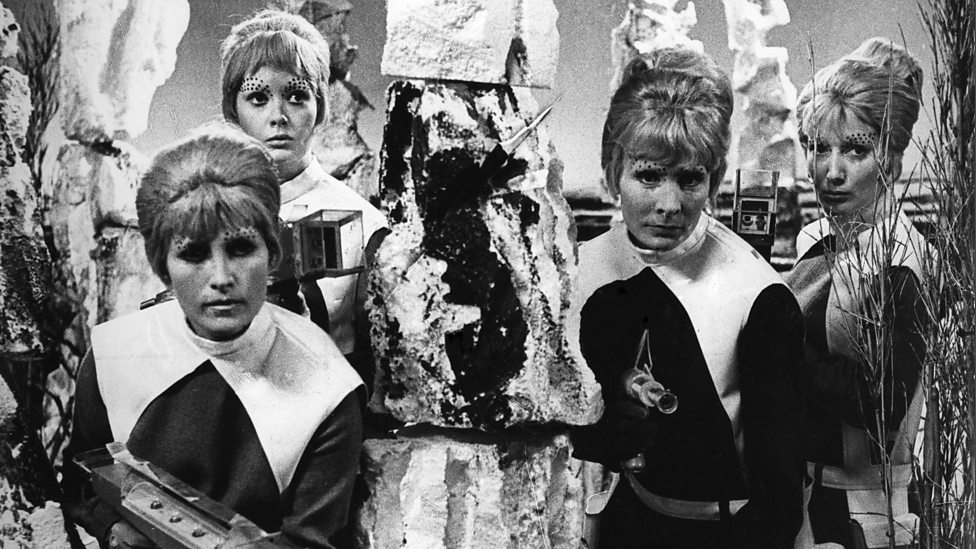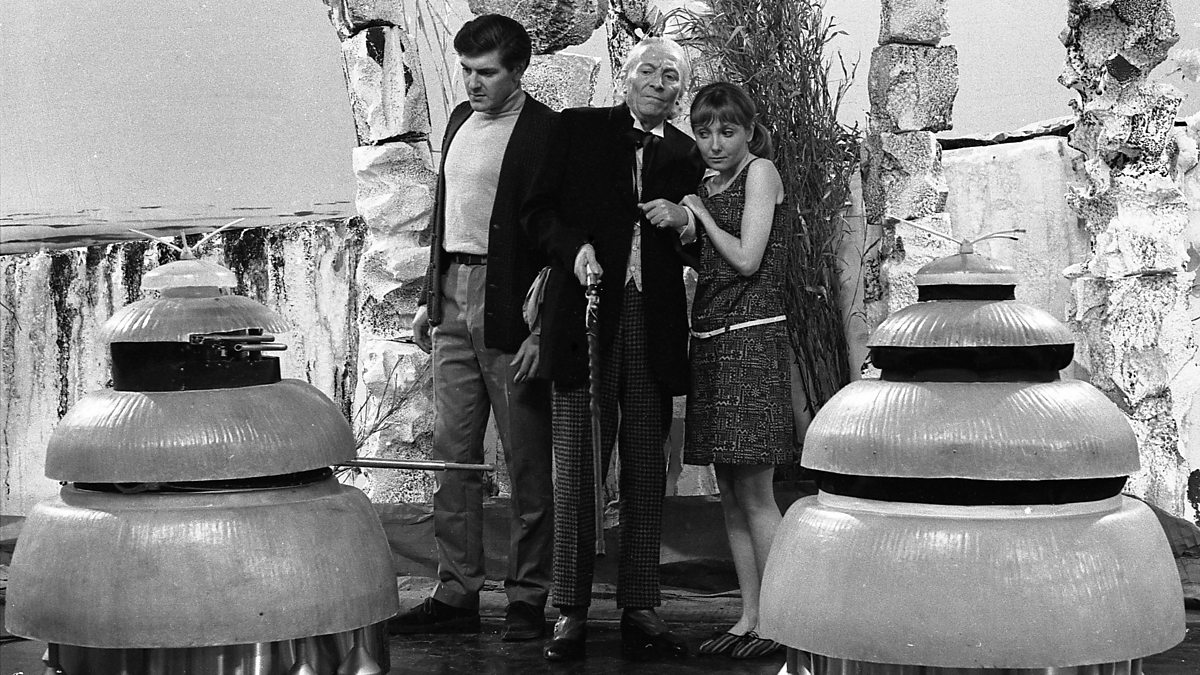‘Galaxy 4’ is an obscure Doctor Who story from 1965 – and one that nearly saw the end of the First Doctor’s era.

In ‘Galaxy 4,’ the Doctor and his companions Steven and Vicki find themselves on an arid planet where two vastly different races are in a stand-off. The female Drahvins and the tentacled Rills have both crashed on a planet that’s set to explode. The species are in a race against time, but the Drahvins – spurred on by their leader, Maaga – plan to steal the Rills’ ship and leave them for dead. With the Doctor and his friends caught in the tussle, it’s not always clear whose side they should be on.
‘Galaxy 4’ was written by William Emms – a self-confessed Doctor Who fan – and it was commissioned by the outgoing producer Verity Lambert in 1965. Indeed, Lambert made some important contributions to the story’s development, suggesting that the Drahvins should be an all-female race. For this reason, the BBC actually owns the partial copyright to the Drahvins, and indeed the new producer John Wiles looked into the rights situation shortly after ‘Galaxy 4’ aired. It’s possible that he was contemplating a sequel, although these plans never came to fruition.

But with ‘Galaxy 4’ being commissioned in 1965, it was originally penned for the earlier TARDIS team of Ian, Barbara and Vicki. However, by the time it went before the cameras, Ian and Barbara had already departed, leaving Steven Taylor (played by Peter Purves) in their stead. As such, certain rewrites had to be done to accommodate the changes – the result being that Steven picked up most of Barbara’s dialogue, and spent the majority of the story shut in an air lock.
This might have been okay had it not been for the fact that Steven’s character was an astronaut. People have commented that it doesn’t make much sense for a spaceman of his standing to walk blindly into an air lock, effectively trapping himself.
Moreover, ‘Galaxy 4’s scripts came in for further criticism from the show’s main stars William Hartnell and Maureen O’Brien (who played Vicki), both of whom were unhappy with some of the dialogue. Apparently, things became so heated between Hartnell and the new producer John Wiles that Wiles threatened to fire the Doctor on the spot if he didn’t stick to Emms’ words.
Thus, ‘Galaxy 4’ nearly marked the end of the First Doctor era. Indeed, things didn’t bode much better for Maureen O’Brien, who was quickly written out at the end of the next story ‘The Myth Makers’ – much to O’Brien’s displeasure.

So as you may have gathered, ‘Galaxy 4’ wasn’t the happiest experience for those involved, but the story proved to be popular with viewers. It launched Doctor Who‘s third season in 1965, and the first episode ‘Four Hundred Dawns’ drew an audience of 9.0 million viewers, which rose to an impressive 11.3 million by the time its third episode ‘Air Lock’ went out.
And speaking of the dreaded ‘Air Lock,’ this is the only complete episode of ‘Galaxy 4’ that’s known to exist. Like all of the First Doctor stories, its master tapes were wiped for re-use, and destruction orders were issued for all surviving film copies. (Even Maaga couldn’t survive the BBC’s archive policy.) ‘Galaxy 4’ fared better than most, though, as the serial existed in its entirety until at least 1977. In fact, an extract from its opening episode was used in the 1977 documentary Whose Doctor Who? – a six minute clip that was later retained by Doctor Who fan Jan Vincent-Rudzki, and still exists to this day. The episodes, however, suffered the same fate as the Drahvins.
Despite this, episode three made its way back to the BBC by way of private film collector Terry Burnett, who had purchased it at a village fete near Southampton in the early 80s, and had been unaware of its significance. He also purchased episode two of ‘The Underwater Menace’ at the same event, and returned both films to the BBC in 2011. ‘Galaxy 4’ was subsequently “completed” in 2012 when the episode was incorporated into a special reconstruction of the story, which premiered on the DVD re-release of ‘The Aztecs.’
The reconstruction also restored some of episode three’s missing footage. This was necessary because, sadly, Burnett’s film was missing the final 27 seconds (including the credits) and the restoration team reconstructed these sections using existing footage and the story’s soundtracks, which had been captured during the original transmission.
Overall, ‘Galaxy 4’ has been well-received in subsequent years. Episode three shows William Hartnell at his eccentric best, and the interplay between himself and the Chumbleys is fun to watch. Moreover, ‘Air Lock’ gives a tantalising glimpse at the tentacled Rills, who hadn’t been seen since the original broadcast. Previously, the only reference material pertaining to these characters had been William Emms’ scripts, and some sketches by Who fan Ian Levine.
But it would be even more fascinating if the fourth episode of ‘Galaxy 4’ turned up. Titled ‘The Exploding Planet,’ the closing moments of this episode lead directly into a mini-story called ‘Mission to the Unknown’ – a prequel to the epic ‘Daleks’ Master Plan,’ which is a firm favourite among fans. (Of course, it would be great if ‘Mission to the Unknown’ could be found as well. Maybe we’ll get lucky, in a few hundred dawns’ time?)
Otherwise, there’s the possibility that the BBC might animate ‘Galaxy 4’ one day. Would you like to see a cartoon version of this story? And what’s your favourite thing about ‘Galaxy 4’? Let me know in the comments below.

Doctor Who Cybermen scarf – order now from the Lovarzi shop!
Shop on Amazon
Latest posts…
- Doctor Who: 5 reasons to watch The Sea Devils
- The Doctor Who deleted scenes you never saw
- Which stories best represent the First Doctor?
- The biggest Doctor Who announcements
- The top 5 Doctor Who logos


Leave a Reply